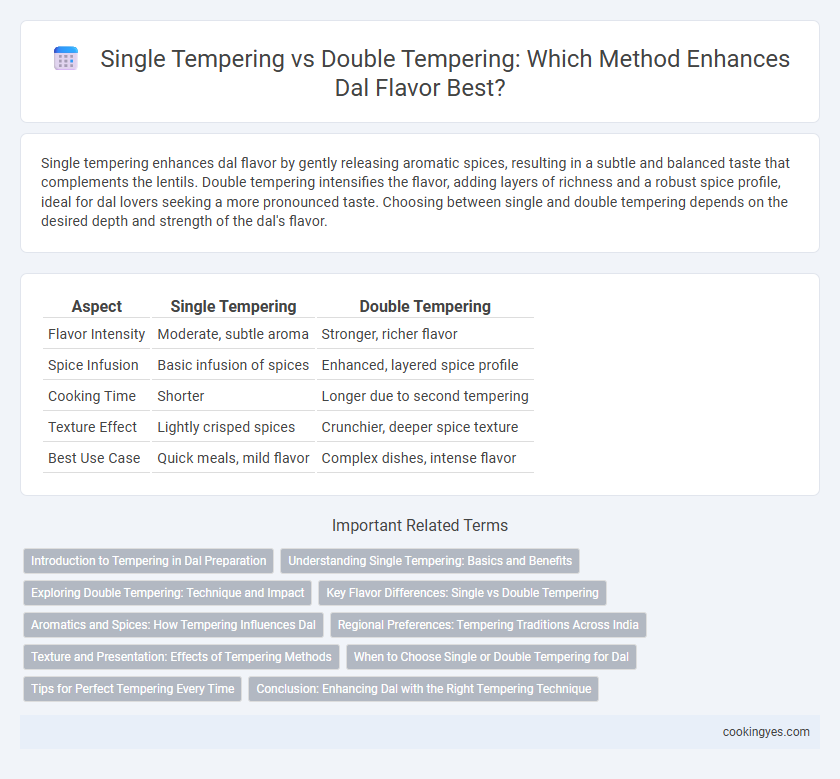Single tempering enhances dal flavor by gently releasing aromatic spices, resulting in a subtle and balanced taste that complements the lentils. Double tempering intensifies the flavor, adding layers of richness and a robust spice profile, ideal for dal lovers seeking a more pronounced taste. Choosing between single and double tempering depends on the desired depth and strength of the dal's flavor.
Table of Comparison
| Aspect | Single Tempering | Double Tempering |
|---|---|---|
| Flavor Intensity | Moderate, subtle aroma | Stronger, richer flavor |
| Spice Infusion | Basic infusion of spices | Enhanced, layered spice profile |
| Cooking Time | Shorter | Longer due to second tempering |
| Texture Effect | Lightly crisped spices | Crunchier, deeper spice texture |
| Best Use Case | Quick meals, mild flavor | Complex dishes, intense flavor |
Introduction to Tempering in Dal Preparation
Tempering in dal preparation involves frying whole spices in hot oil or ghee to release essential oils and enhance flavor depth. Single tempering applies this process once, providing a subtle aromatic infusion, while double tempering involves tempering twice, intensifying the spice profile and richness. The choice between single and double tempering significantly impacts the dal's flavor complexity and aroma, making it key to tailored taste preferences.
Understanding Single Tempering: Basics and Benefits
Single tempering in dal involves tempering the spices once during the cooking process, which enhances the overall flavor profile by infusing aromatic oils directly into the lentils. This method preserves the natural texture of dal while providing a subtle depth of taste, making it ideal for simple, everyday dal recipes. The benefits include reduced cooking time, ease of preparation, and a balanced, consistent flavor that highlights the dal's inherent earthiness.
Exploring Double Tempering: Technique and Impact
Double tempering dal involves adding tempered spices twice--once during the cooking process and again just before serving--intensifying the aroma and flavor profile significantly. This technique enhances the infusion of spices like mustard seeds, cumin, and curry leaves, resulting in a richer, more complex taste compared to single tempering. The controlled release of essential oils from spices during double tempering elevates the dal's sensory experience and retains freshness for longer.
Key Flavor Differences: Single vs Double Tempering
Single tempering of dal introduces a bold, sharp flavor by frying spices once in hot oil, allowing the essential oils to infuse the dish with a distinct aroma and a crisp texture. Double tempering involves frying the spices twice, which deepens the flavor profile, resulting in a richer, more layered taste with intensified spice notes. Single tempering highlights fresh and vibrant spice characteristics, while double tempering enhances complexity and creates a lingering, robust flavor experience in dal.
Aromatics and Spices: How Tempering Influences Dal
Single tempering infuses dal with a concentrated burst of aromatics and spices, allowing mustard seeds, cumin, and dried red chilies to release their essential oils directly into the dish. Double tempering enhances complexity by layering flavors; the initial tempering cooks the base aromatics while the second freshens and intensifies the spice profile just before serving. This technique enriches dal's fragrance and depth, creating a more vibrant and balanced taste experience.
Regional Preferences: Tempering Traditions Across India
Single tempering in dal typically enhances a straightforward, robust flavor preferred in North Indian cuisines, where spices like cumin, mustard seeds, and garlic are commonly used for a clean, earthy taste. Double tempering, involving two stages of frying spices, is favored in South Indian regions such as Tamil Nadu and Kerala, intensifying aroma and depth with ingredients like curry leaves, dried red chilies, and asafoetida. These regional tempering traditions reflect distinct culinary cultures, balancing boldness and subtlety to complement local dal varieties.
Texture and Presentation: Effects of Tempering Methods
Single tempering enhances dal's texture by providing a mild, consistent flavor infusion and a slightly softer grain, improving overall mouthfeel. Double tempering intensifies the flavor complexity and creates a more visually appealing dal with richer oil dispersion and a glossier appearance. The choice between single and double tempering directly influences the dal's texture firmness and presentation vibrancy, catering to different culinary preferences.
When to Choose Single or Double Tempering for Dal
Single tempering in dal is ideal when aiming for a subtle infusion of spices that enhances the natural flavor without overpowering it, typically used for lighter dals like moong or masoor. Double tempering is preferred for robust dals such as chana or toor, where the second tempering layer, added just before serving, intensifies aroma and adds a fresh burst of flavor. Choose single tempering for quicker meals requiring gentle spice blends, while double tempering suits dishes intended for richer, more complex taste profiles, often found in festive or elaborate meals.
Tips for Perfect Tempering Every Time
Single tempering enhances dal flavor by releasing essential spices' aromas gently, while double tempering introduces deeper, layered tastes through a second burst of heat and spices. To achieve perfect tempering every time, use fresh mustard seeds and cumin, heat oil until shimmering but not smoking, and add spices in order of their cooking times to avoid burning. Stir continuously and pour the tempering immediately over the cooked dal to preserve the optimal flavor and aroma.
Conclusion: Enhancing Dal with the Right Tempering Technique
Single tempering enhances dal flavor by infusing spices gently, preserving the subtle aroma of ingredients like cumin, mustard seeds, and curry leaves. Double tempering intensifies flavors by incorporating layered spice roasting, ideal for richer dal varieties such as masoor or toor dal. Choosing between single and double tempering depends on the desired flavor complexity, with double tempering offering a robust taste profile while single tempering maintains delicate balance.
Single Tempering vs Double Tempering for Dal Flavor Infographic

 cookingyes.com
cookingyes.com